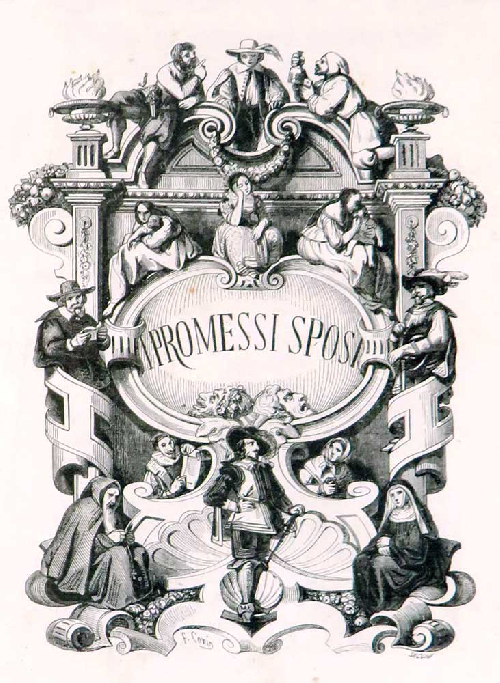

| Non hai nessun prodotto nel carrelloCHIUDI X |
Alessandro Manzoni
I Promessi Sposi, storia milanese del secolo XVII scoperta e rifatta da Alessandro Manzoni. Edizione riveduta dall’autore — Storia della Colonna Infame, inedita
Milano [Milan], dalla Tipografia Guglielmini e Redaelli, 1840.
Second official edition, augmented and revised. First definitive edition.
Thirteen years after the first edition of The betrothed, Manzoni was ready to print the definitive, profoundly revised and augmented second edition of his masterpiece, the most important Italian novel of the Eighteen-hundreds.
Published in instalments between 1840 and 1842, it is nicknamed “quarantana” (an adjectival form for 40 — short for 1840 — used uniquely for this book on the basis of “ventisettana”, an adjectival form for 27 — short for 1827 – used uniquely for the first edition). The date 1840 appears on the title page, though printing went on until 1845: Manzoni was never quite satisfied with his novel and emended it continuously while it was being printed, which resulted in a number of minute differences that can be traced to a specific “print run”. About 4500 copies were printed.

Three elements make this edition different from the first: Manzoni removed any trace of Lombard words that had appeared in the “ventisettana” and made it a true “Tuscan” novel; he printed the book with many woodcuts depicting specific episodes and characters: Manzoni himself giving the artists precise details on backgrounds and how to “frame” their drawings, encouraging them to consult illustrated historical documents in order to reproduce clothing, furniture, landscapes and Seventeenth-century Lombard architecture more realistically; and, as an appendix, he published Storia della colonna infame (“Story of the column of shame”), a historical essay originally meant to be a chapter in the first edition which further explores trials during the plague that struck Milan in 1630.
Manzoni decided to publish his novel as a serial: every fortnight an instalment consisting of 16 pages was sold for 40 lire. But such a high number of printed pages (some of them illustrated) posed a number of technical challenges, so the printers Guglielmi and Redaelli had to import a Stanhope press, made entirely in metal, far bigger and far more efficient than the old wooden press, especially for printing illustrated books: woodcuts enhanced the aesthetic value of books and also made them extremely hard to pirate.

Manzoni’s first choice for the illustrations was the celebrated painter Francesco Hayez, who had provided drawings for other books, including a translation of Scott’s Ivanhoe; he began working on The betrothed, but stepped down after his first attempts proved surprisingly poor. The author turned to his family friend Francesco Gonin, an eclectic artist who could draw portraits, landscapes and urban life with equal ease; Gonin accepted and worked alone on most of the book’s 400 illustrations (only a handful were drawn by other artists under his guidance). Manzoni was so pleased with his work that he called Gonin an “admirable translator” of his novel. Some of the finest woodcutters in Europe (Sheers from England, Bernard, Pollet and Louyseau from France) were then called to Milan to work on the book. The artist Luigi Sacchi, who had gathered a vast experience in print by working on images in newspapers, oversaw the printing process. Manzoni emended passages in his novel constantly, and (where necessary) Sacchi applied subtle changes to the woodcuts accordingly.
Having assembled such expensive machinery and such a team of expert artists, Manzoni decided to even the expenses by having the same men and machines print the marvellous second illustrated edition of Milanese poet Carlo Porta’s works while still at work on The betrothed: Porta, item 27.The column of shame

Critics mostly agree that The column of shame should be thought of the last chapter of The betrothed, as Manzoni himself intended it to be: after researching the case carefully, reading contemporary chronicles and transcriptions of trials (though his main source was Pietro Verri’s Osservazioni sulla tortura, «Observations on torture», an essay focusing on similar matters printed in 1804), he intended to publish it as a chapter in Fermo e Lucia («Fermo and Lucia», which he had already abandoned in 1823), but soon discovered that he would need a much longer text to relay the case and his thoughts on the matter, and decided that he would print Appendice sulla storia della colonna infame («Appendix on the story of the column of shame») as an appendix to his novel. Fermo and Lucia was discarded and became The betrothed; the author, unsatisfied with his Column of shame, did not publish it in the first edition; by omitting the word “appendix” from the title, Manzoni ultimately made it part of the novel.

Historians rejected his work well into the Twentieth century; only in 1942 did they start re-evaluating The column of shame, when a new edition of the novel was printed. The prominent novelist Alberto Moravia wrote in a review that «Manzoni was no historian, he was a poet and a novelist; but today’s readers must be grateful for “his” story, for giving us a perspective on his passion for ethics different from the one we already knew from The betrothed».
The essay focuses on poor choices made by the Lombard government in managing the outbreak of the plague in 1630: the “column of shame” was erected where two innocent men were executed for spreading the plague. Destroyed in 1778, the column had in time become a monument to shame juridical errors and not the accused.

Conditions
In 8°, contemporary binding in green morocco with the owner’s monogram «A B» (Adolfo Bauer), spine lettered gilt to the second compartment; endpapers in white silk, edges gilt, pp. 864; text framed in double fillet black.This copy belongs to the so called «Classe II», a corrected state of the print run with a few emended errors, such as «spavento» instead of «terrore» (page 403, line 30). Slight foxing throughout, but a fine wide-margined copy (270 x 180 mm) from a prestigious private collection, inscribed by the author: «All’Egregio Sign.r Dottore Adolfo Bauer | Omaggio cordiale d Alessandro Manzoni» («For the eminent doctor Adolfo Bauer, a friendly homage from Alessandro Manzoni»). Bauer was a respected dentist who worked in Milan in the mid-Eighteen-hundreds.
Bibliography
Brancaccio, Antonella, Dal block-notes del ‘regista’ al racconto per immagini dell’«ammirabile traduttore». Manzoni, Gonin e la Quarantana illustrata, in La letteratura italiana e le arti. Atti del XX Congresso dell’ADI - Associazione degli Italianisti (Napoli, 7-10 settembre 2016), a c. di L. Battistini et alii, Roma, Adi editore, 2018. ONLINE
De Blasi, Margherita, Dal romanzo della tortura ai Promessi sposi. Manzoni lettore di Verri, in L’Italianistica oggi: ricerca e didattica, Atti del XIX Congresso dell’ADI - Associazione degli Italianisti (Roma, 9-12 settembre 2015), a c. di B. Alfonzetti et alii, Roma, Adi editore, 2017. ONLINE
Fahy, Conor, Per la stampa dell'edizione definitiva dei Promessi sposi, «Aevum», 3 (1982), pp. 377-394. ONLINE
L’officina dei Promessi sposi, a c. di Fernando Mazzocca, con intervento critico di D. Isella, Milano, Mondadori, 1985. ONLINE
Manzoni, Alessandro, I promessi sposi. Testo del 1840-42, a c. di T. Poggi Salani, Milano, Centro Nazionale Studi Manzoniani, «Edizione nazionale ed europea delle opere di Alessandro Manzoni», 2, 2013. ONLINE
Manzoni, Alessandro, I promessi sposi. Storia della colonna infame, a c. di S.S. Nigro - E. Paccagnini, Milano, Mondadori («i Meridiani»), 2002. ONLINE
Mazzocca, Fernando, Quale Manzoni? Vicende figurative dei Promessi sposi, Milano, il Saggiatore, 1985. ONLINE
Parenti, Marino, Manzoni editore. Storia di una celebre impresa manzoniana, Bergamo, Istituto italiano d'arti grafiche, 1945. ONLINE
Libreria Antiquaria Pontremoli P.IVA 10060360962 | © 2024 Web & Com ® | Area riservata

 MENU
MENU




